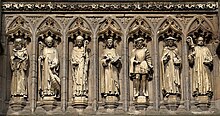Henry Hastings, 3rd Earl of Huntingdon
[1] His father was a political ally of John Dudley, 1st Duke of Northumberland, and to further their alliance the two elder politicians arranged the marriage of their children.
Due to his marital alliance, Henry backed Northumberland in his attempt to divert the succession in favour of Lady Jane Grey in July 1553, and on Mary Tudor's triumph he found himself incarcerated in the Tower of London.
[citation needed] Henry entered the household of his great-uncle Cardinal Reginald Pole and followed him in his visits to Calais, Flanders and the monasteries of Smithfield, London.
Despite his personal loyalty to Mary and his great-uncle, Hastings practised Calvinism and showed little financial restraint in supporting his puritan beliefs.
When Mary I died childless and was succeeded by her younger half-sister Elizabeth I in 1558, the new queen also counted on the reliable Hastings family among her supporters.
With his humanist education, experience of court life, and a brother-in-law, Robert Dudley, high in the new queen's favour, Huntingdon might well have expected early advancement.
However, at the time few members of the Tudor dynasty remained alive and several descendants of the previous English royal house of Plantagenet were seen as possible heirs to the throne.
Indeed, when Elizabeth fell ill with smallpox in October 1562, the Protestant group put him forward as a potential successor and, though he subsequently did all in his power to convince her of his loyalty, the queen proved very slow thereafter to employ him outside his native county of Leicestershire.
For three months during the northern uprising in the autumn of 1569, he assisted George Talbot, 6th Earl of Shrewsbury to remove the Scottish queen from Wingfield Manor to Tutbury.
Elizabeth formally recognised his service by creating him a Knight of the Garter in April 1570 alongside William Somerset, 3rd Earl of Worcester, and from this time seems to have regarded him as a candidate for promotion.

